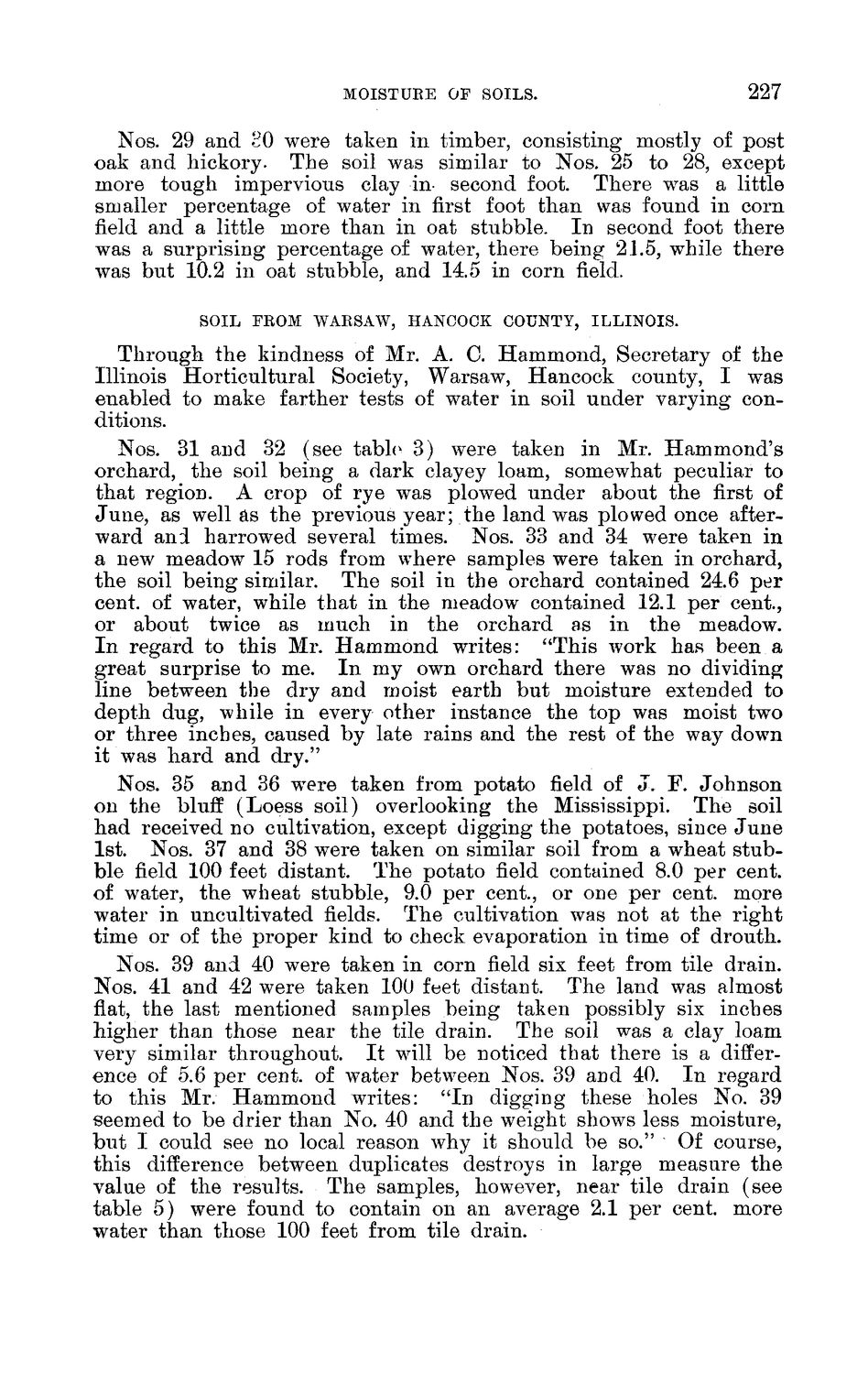| |
| |
Caption: Board of Trustees Minutes - 1888
This is a reduced-resolution page image for fast online browsing.

EXTRACTED TEXT FROM PAGE:
MOISTURE OF SOILS. 227 Nos. 29 and H were taken in timber, consisting mostly of post O oak and hickory. The soil was similar to Nos. 25 to 28, except more tough impervious clay in- second foot. There was a little smaller percentage of water in first foot than was found in corn field and a little more than in oat stubble. In second foot there was a surprising percentage of water, there being 21.5, while there was but 10.2 in oat stubble, and 14.5 in corn field. SOIL FROM WARSAW, HANCOCK COUNTY, ILLINOIS. Through the kindness of Mr. A. C. Hammond, Secretary of the Illinois Horticultural Society, Warsaw, Hancock county, I was enabled to make farther tests of water in soil under varying conditions. Nos. 31 and 32 (see table 3) were taken in Mr. Hammond's orchard, the soil being a dark clayey loam, somewhat peculiar to that region. A crop of rye was plowed under about the first of June, as well as the previous year; the land was plowed once afterward and harrowed several times. Nos. 33 and 34 were taken in a new meadow 15 rods from where samples were taken in orchard, the soil being similar. The soil in the orchard contained 24.6 per cent, of water, while that in the meadow contained 12.1 per cent., or about twice as much in the orchard as in the meadow. I n regard to this Mr. Hammond writes: "This work has been a great surprise to me. I n my own orchard there was no dividing line between the dry and moist earth but moisture extended to depth dug, while in every other instance the top was moist two or three inches, caused by late rains and the rest of the way down it was hard and dry." Nos. 35 and 36 were taken from potato field of J. F. Johnson on the bluff (Loess soil) overlooking the Mississippi. The soil had received no cultivation, except digging the potatoes, since June 1st. Nos. 37 and 38 were taken on similar soil from a wheat stubble field 100 feet distant. The potato field contained 8.0 per cent, of water, the wheat stubble, 9.0 per cent., or one per cent, more water in uncultivated fields. The cultivation was not at the right time or of the proper kind to check evaporation in time of drouth. Nos. 39 and 40 were taken in corn field six feet from tile drain. Nos. 41 and 42 were taken 100 feet distant. The land was almost flat, the last mentioned samples being taken possibly six inches higher than those near the tile drain. The soil was a clay loam very similar throughout. I t will be noticed that there is a difference of 5.6 per cent, of water between Nos. 39 and 40. I n regard to this Mr. Hammond writes: "In digging these holes No. 39 seemed to be drier than No. 40 and the weight shows less moisture, but I could see no local reason why it should be so." Of course, this difference between duplicates destroys in large measure the value of the results. The samples, however, near tile drain (see table 5) were found to contain on an average 2.1 per cent, more water than those 100 feet from tile drain.
| |